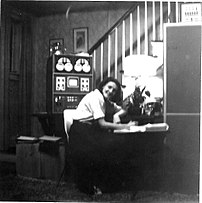|
Mary Allen Wilkes
Mary Allen Wilkes (born September 25, 1937) is a lawyer, former computer programmer and logic designer, known for her work with the LINC computer, now recognized by many as the world's first "personal computer".[1] CareerWilkes was born in Chicago, Illinois and graduated from Wellesley College in 1959 where she majored in philosophy and theology.[2] Wilkes planned to become a lawyer, but was discouraged by friends and mentors from pursuing law because of the challenges women faced in the field.[3] A geography teacher in the eighth grade had told Wilkes, "Mary Allen, when you grow up, you ought to be a computer programmer."[4] She worked in the field as one of the first programmers for a number of years before pursuing law and becoming an attorney in 1975.[5] MITWilkes worked under Oliver Selfridge and Benjamin Gold on the Speech Recognition Project at MIT's Lincoln Laboratory in Lexington, Massachusetts from 1959 to 1960, programming the IBM 704 and the IBM 709.[6] She joined the Digital Computer Group, also at Lincoln Laboratory, just as work was beginning on the LINC design under Wesley A. Clark in June 1961. Clark had earlier designed Lincoln's TX-0 and TX-2 computers. Wilkes's contributions to the LINC development included simulating the operation of the LINC during its design phase on the TX-2,[6] designing the console for the prototype LINC and writing the operator's manual for the final console design.[7] In January, 1963, the LINC group left Lincoln Laboratory to form the Center for Computer Technology in the Biomedical Sciences at MIT's Cambridge, Massachusetts campus, where, in the summer of 1963 it trained the first participants in the LINC Evaluation Program, sponsored by the National Institutes of Health.[8] Wilkes taught participants in the program and wrote the early LINC Assembly Programs (LAP) for the 1024-word LINC. She also co-authored the LINC's programming manual, Programming the LINC with Wesley A. Clark.[9] Washington University In the summer of 1964 a core group from the LINC development team left MIT to form the Computer Systems Laboratory at Washington University in St. Louis.[10] Wilkes, who had spent 1964 traveling around the world, rejoined the group in late 1964, but lived and worked from her parents' home in Baltimore until late 1965. She worked there on a LINC provided by the Computer Systems Laboratory and is usually considered to be the first user of a personal computer in the home.[11][12] By 1965, the LINC team had doubled the size of the LINC memory to 2048 12-bit words, which enabled Wilkes to develop the more sophisticated operating system, LAP6. LAP6 incorporated a scroll editing technique which made use of an algorithm proposed by her colleagues, Mishell J. Stucki and Severo M. Ornstein.[13] LAP6, which has been described as "outstandingly well human engineered",[14] provided the user the ability to prepare, edit, and manipulate documents (usually LINC programs) interactively in real time, using the LINC's keyboard and display, much like later personal computers. The LINC tapes performed the function of the scroll, and also provided interactive filing capabilities for documents and programs. Program documents could be converted to binary and run. Users could integrate their own programs with LAP6 using a link provided by the system, and swap the small LINC tapes around to share programs, an early "open source" capability. Some of this work took place on a LINC machine installed in her parents' house in Baltimore. In interview she was asked if this made her the first person to use a computer in a private residence, she replied "Well, I guess I might have been...".[15] The Computer Systems Laboratory's next project, also headed by Clark, was the design of "Macromodules", computer building blocks.[16] Wilkes designed the multiply macromodule, the most complex of the set. Law careerWilkes left the computer field in 1972 to attend the Harvard Law School. She practiced as a trial lawyer for many years, both in private practice and as head of the Economic Crime and Consumer Protection Division of the Middlesex County District Attorney's Office in Massachusetts. She taught in the Trial Advocacy Program at the Harvard Law School from 1983 to 2011, and sat as a judge for the school's first- and second-year Ames (moot court) competition for 18 years. In 2001 she became an arbitrator for the American Arbitration Association, sitting primarily on cases involving computer science and information technology. From 2005 through 2012, she served as a judge of the Annual Willem C. VIS International Commercial Arbitration Moot competition in Vienna, Austria, organized by Pace University Law School. NotabilityShe is noted in the field of computer science for:
Her work has been recognized in Great Britain's National Museum of Computing's 2013[17] exhibition "Heroines of Computing" at Bletchley Park,[18] and by the Heinz Nixdorf Museums Forum in Paderborn, Germany, in its 2015-16 exhibition, Am Anfang war Ada: Frauen in der Computergeschichte (In the beginning was Ada: Women in Computer History).[19] Quotes
Selected publications
References
|
||||||||||||||||
